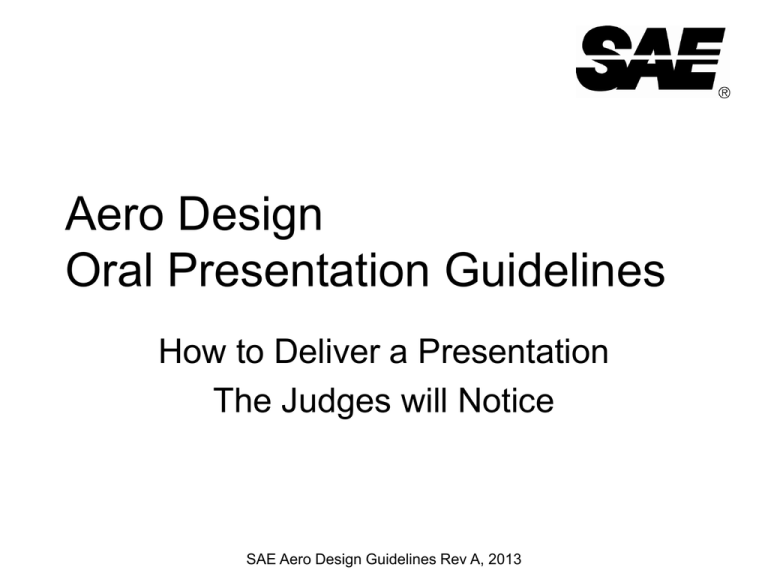
Aero Design
Oral Presentation Guidelines
How to Deliver a Presentation
The Judges will Notice
SAE Aero Design Guidelines Rev A, 2013
Purpose
This document has been prepared to give
teams competing in the SAE Aero Design
contests a better understanding of the
elements judges expect to find in the Oral
Presentation. This document is also
intended to walk teams through the design
process; by carefully reading this
presentation, teams may discover key
elements of aircraft design that can help
them create better performing aircraft.
SAE Aero Design Guidelines Rev A, 2013
Sample Outline
•
•
•
•
•
•
•
•
•
•
•
Design Objectives
Team Process
Vehicle Sizing
Configuration Selection
Propulsion
Structural Concept & Materials
Stress Analysis
Stability & Control
Advance Class Flight Systems
Performance Analysis
Empirical Results
SAE Aero Design Guidelines Rev A, 2013
Design Objectives
• Analyze the Relevant Scoring Formula
– Plot it, in Three Dimensions if Req’d
• Observe the Mission Parameters
• Note Any Special Requirements
– Wing Span
– Propulsion Limitations
• Succinctly State the Objective in Your
Own Words
SAE Aero Design Guidelines Rev A, 2013
Team Process
• Team Organization
• Work Breakdown Structure
• Schedule w/Key Milestones
– Conceptual Design Review
– Preliminary Design Review
– Critical Design Review
– Construction
– Flight Test
SAE Aero Design Guidelines Rev A, 2013
Vehicle Sizing
• Determine Wing Loading, Planform Area
• Select Aspect Ratio Span & Chord
• Select Airfoil
– Consider All Elements of Performance (CLmax,
stall performance, drag)
– Consider Reasonable Building Constraints
(such as trailing edge thickness) and their
Impact Upon Performance
SAE Aero Design Guidelines Rev A, 2013
Configuration Selection
• Conventional, Canard, Tailless Flying Wing, Delta,
Biplane, Monoplane, etc.
– Analyze the pros & cons of each
– Select based upon best fit with design objectives
– Pay Attention to Requirements
• Tricycle or Taildragger
– Don’t Halt Analysis at Weight Only
– Consider the Operating Environment!
• Wing Placement: High, Mid, Low
– Consider Stability Implications
– Structural Implications
• Propulsion Installation
SAE Aero Design Guidelines Rev A, 2013
Propulsion
• Advance Class
– Two or Four Stroke
– Size, Number of Engines
– Consider Torque Curves in Addition to Power Curves
• Micro Class (all electric class)
– Electric Propulsion System Choice/Analysis
– Reliability
• All Classes
– Propeller Selection—Don’t just use what the
manufacturer recommends!
– Consider Dynamic Thrust, not just Static Thrust
SAE Aero Design Guidelines Rev A, 2013
Structural Concept &
Materials
•
•
•
•
Build Accuracy
Durability
Schedule Constraints
Weight Buildup
– Initial Estimates
– Final Results
SAE Aero Design Guidelines Rev A, 2013
Stress Analysis
•
•
•
•
Load Factor
Factor of Safety
Wing Strength
Load Path for Payload
– In Flight
– During Landing
• Landing Gear
• If Your Design Includes “Flying Wires,” Include
Them in the Analysis
SAE Aero Design Guidelines Rev A, 2013
Stability & Control
• Static Margin
• Lateral/Directional Derivatives
• Dihedral, Polyhedral, or Flat?
SAE Aero Design Guidelines Rev A, 2013
Advance Class Flight
Systems
• Requirements
• Hardware/Software
• System Performance
SAE Aero Design Guidelines Rev A, 2013
Performance
• Takeoff Distance
– Wind or No Wind? Why Consider Wind?
– If Wind, How Much?
• Payload Prediction
– State Prediction Under Most Likely Local
Conditions
• Stopping Distance
– Assume a Reasonable Touchdown Point
– Remember You’re Dissipating Energy
SAE Aero Design Guidelines Rev A, 2013
Empirical Results
• Results of Flight Test
– What Worked As Predicted
– What Didn’t, and Why Not
– What Was Changed as a Result
SAE Aero Design Guidelines Rev A, 2013





